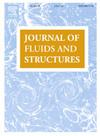设计波浪和极端响应的M4浮动,铰接波浪能量转换器
IF 3.4
2区 工程技术
Q1 ENGINEERING, MECHANICAL
引用次数: 0
摘要
本文介绍了对波浪盆地运动测量结果的综合分析,该运动研究了设计波对M4波浪能量转换器(WEC)铰链响应的使用。目前正在西澳大利亚州奥尔巴尼海岸附近的乔治国王海峡进行一项千瓦时规模的海洋试验,实验以1:15的比例进行。通过对极端海况下长不规则波浪实现的最大身体运动反应进行平均,我们确定了最可能的极端反应——新反应。设计波是通过对驱动最大响应实例的地表高程时间历史进行平均来构建的。随后,确定的设计波在波盆中被复制。结果表明,所识别的设计波能够以合理的精度产生M4装置的铰链角NewResponse。该方法适用于任何线性系统,并且这种类型的设计波有望适用于大范围的WEC运动响应。除了对确定的设计波信号进行实验重建外,我们还分析了浸没的影响-中心浮子完全淹没-并比较了与乔治王海峡位置相关的三种严重海况的最大响应和设计波信号。在限陡严重海况下,波浪峰值频率低于铰链运动固有频率,新响应与海况无关。然而,设计波被发现在某种程度上取决于海况。我们将这两个发现与铰链响应在其固有频率下的窄带性质和固定波陡度下频谱尾的不变性联系起来。本文章由计算机程序翻译,如有差异,请以英文原文为准。
Design Waves and extreme responses for an M4 floating, hinged wave energy converter
This paper presents a comprehensive analysis of measurements from a wave basin campaign investigating the use of Design Waves for the hinge response of the M4 wave energy converter (WEC). The experiments were carried out at a scale of 1:15 relative to a kW-scale ocean trial currently being built for deployment in King George Sound, off the coast of Albany, Western Australia. By averaging the largest body motion responses from long irregular wave realisations of extreme sea states, we determined the most probable extreme response — the NewResponse. The Design Wave was constructed by averaging the surface elevation time histories driving instances of the largest responses. Subsequently, the identified Design Wave was replicated in the wave basin. Our results show that the identified Design Wave is able to produce the hinge angle NewResponse of the M4 device with reasonable accuracy. The methodology applies to any linear system, and Design Waves of this type are expected to be applicable for a wide range of WEC motion responses. In addition to the experimental reconstruction of identified Design Wave signals, we analyse the effect of dunking – full submergence of the centre floats – and compare the maximum response and Design Wave signals for three severe sea states pertinent to the King George Sound location. In limiting-steepness severe sea states, the wave peak frequency is lower than the hinge motion natural frequency, and the NewResponse is largely independent of the sea state. However, the Design Waves are found to be somewhat sea state dependent. We relate both of these findings to the narrow-band nature of the hinge response at its natural frequency and the invariance of the spectral tail for fixed wave steepness.
求助全文
通过发布文献求助,成功后即可免费获取论文全文。
去求助
来源期刊

Journal of Fluids and Structures
工程技术-工程:机械
CiteScore
6.90
自引率
8.30%
发文量
173
审稿时长
65 days
期刊介绍:
The Journal of Fluids and Structures serves as a focal point and a forum for the exchange of ideas, for the many kinds of specialists and practitioners concerned with fluid–structure interactions and the dynamics of systems related thereto, in any field. One of its aims is to foster the cross–fertilization of ideas, methods and techniques in the various disciplines involved.
The journal publishes papers that present original and significant contributions on all aspects of the mechanical interactions between fluids and solids, regardless of scale.
 求助内容:
求助内容: 应助结果提醒方式:
应助结果提醒方式:


